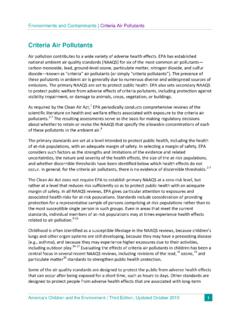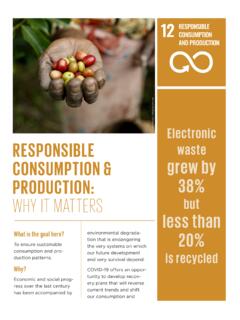Transcription of 3.1 Stationary Gas Turbines
1 4/00 Stationary Internal Combustion Stationary Gas General1 Gas Turbines , also called combustion Turbines , are used in a broad scope of applicationsincluding electric power generation, cogeneration, natural gas transmission, and various processapplications. Gas Turbines are available with power outputs ranging in size from 300 horsepower (hp) toover 268,000 hp, with an average size of 40,200 The primary fuels used in gas Turbines are naturalgas and distillate (No. 2) fuel Process Description1,2A gas turbine is an internal combustion engine that operates with rotary rather than reciprocatingmotion.
2 Gas Turbines are essentially composed of three major components: compressor, combustor, andpower turbine . In the compressor section, ambient air is drawn in and compressed up to 30 times ambientpressure and directed to the combustor section where fuel is introduced, ignited, and burned. Combustorscan either be annular, can-annular, or silo. An annular combustor is a doughnut-shaped, single, continuouschamber that encircles the turbine in a plane perpendicular to the air flow. Can-annular combustors aresimilar to the annular; however, they incorporate several can-shaped combustion chambers rather than asingle continuous chamber.
3 Annular and can-annular combustors are based on aircraft turbine technologyand are typically used for smaller scale applications. A silo (frame-type) combustor has one or morecombustion chambers mounted external to the gas turbine body. Silo combustors are typically larger thanannular or can-annular combustors and are used for larger scale combustion process in a gas turbine can be classified as diffusion flame combustion, or lean-premix staged combustion. In the diffusion flame combustion, the fuel/air mixing and combustion takeplace simultaneously in the primary combustion zone.
4 This generates regions of near-stoichiometricfuel/air mixtures where the temperatures are very high. For lean-premix combustors, fuel and air arethoroughly mixed in an initial stage resulting in a uniform, lean, unburned fuel/air mixture which isdelivered to a secondary stage where the combustion reaction takes place. Manufacturers use differenttypes of fuel/air staging, including fuel staging, air staging, or both; however, the same staged, lean-premixprinciple is applied. Gas Turbines using staged combustion are also referred to as Dry Low NOX combustors. The majority of gas Turbines currently manufactured are lean-premix staged gases from the combustion section are diluted with additional air from the compressor sectionand directed to the power turbine section at temperatures up to 2600oF.
5 Energy from the hot exhaust gases,which expand in the power turbine section, are recovered in the form of shaft horsepower. More than50 percent of the shaft horsepower is needed to drive the internal compressor and the balance of recoveredshaft horsepower is available to drive an external Gas Turbines may have one, two, or three shafts totransmit power between the inlet air compression turbine , the power turbine , and the exhaust turbine . Theheat content of the exhaust gases exiting the turbine can either be discarded without heat recovery (simplecycle); recovered with a heat exchanger to preheat combustion air entering the combustor (regenerativecycle); recovered in a heat recovery steam generator to raise process steam, with or without supplementaryfiring (cogeneration); or recovered, with or without supplementary firing, to raise steam for a steam turbineRankine cycle (combined cycle or repowering).
6 FACTORS4/00 The simple cycle is the most basic operating cycle of gas Turbines with a thermal efficiency rangingfrom 15 to 42 percent. The cycle thermal efficiency is defined as the ratio of useful shaft energy to fuelenergy input. Simple cycle gas Turbines are typically used for shaft horsepower applications withoutrecovery of exhaust heat. For example, simple cycle gas Turbines are used by electric utilities forgeneration of electricity during emergencies or during peak demand regenerative cycle is a simple cycle gas turbine with an added heat exchanger. The heatexchanger uses the turbine exhaust gases to heat the combustion air which reduces the amount of fuelrequired to reach combustor temperatures.
7 The thermal efficiency of a regenerative cycle is approximately35 percent. However, the amount of fuel efficiency and saving may not be sufficient to justify the capitalcost of the heat exchanger, rendering the process cogeneration cycle consists of a simple cycle gas turbine with a heat recovery steam generator(HRSG). The cycle thermal efficiency can be as high as 84 percent. In a cogeneration cycle, the steamgenerated by the HRSG can be delivered at a variety of pressures and temperatures to other thermalprocesses at the site. For situations where additional steam is required, a supplementary burner, or ductburner, can be placed in the exhaust duct stream of the HRSG to meet the site s steam combined cycle gas turbine is a gas turbine with a HRSG applied at electric utility sites.
8 Thegas turbine drives an electric generator, and the steam from the HRSG drives a steam turbine which alsodrives an electric generator. A supplementary-fired boiler can be used to increase the steam production. The thermal efficiency of a combined cycle gas turbine is between 38 percent and 60 turbine applications include gas and oil industry, emergency power generation facilities,independent electric power producers (IPP), electric utilities, and other industrial applications. Thepetroleum industry typically uses simple cycle gas Turbines with a size range from 300 hp to 20,000 hp.
9 The gas turbine is used to provide shaft horsepower for oil and gas production and transmission. Emergency power generation sites also utilize simple cycle gas Turbines . Here the gas turbine is used toprovide backup or emergency power to critical networks or equipment. Usually, gas Turbines under 5,000hp are used at emergency power generation sites. Independent electrical power producers generate electricity for resale to larger electric utilities. Simple, regenerative, or combined cycle gas Turbines are used at IPP; however, most installations usecombined cycle gas Turbines .
10 The gas Turbines used at IPP can range from 1,000 hp to over 100,000 hp. The larger electric utilities use gas Turbines mostly as peaking units for meeting power demand peaksimposed by large commercial and industrial users on a daily or seasonal basis. Simple cycle gas turbinesranging from 20,000 hp to over 200,000 hp are used at these installations. Other industrial applications forgas Turbines include pulp and paper, chemical, and food processing. Here, combined cycle gas Turbines areused for EmissionsThe primary pollutants from gas turbine engines are nitrogen oxides (NOX), carbon monoxide(CO), and to a lesser extent, volatile organic compounds (VOC).















